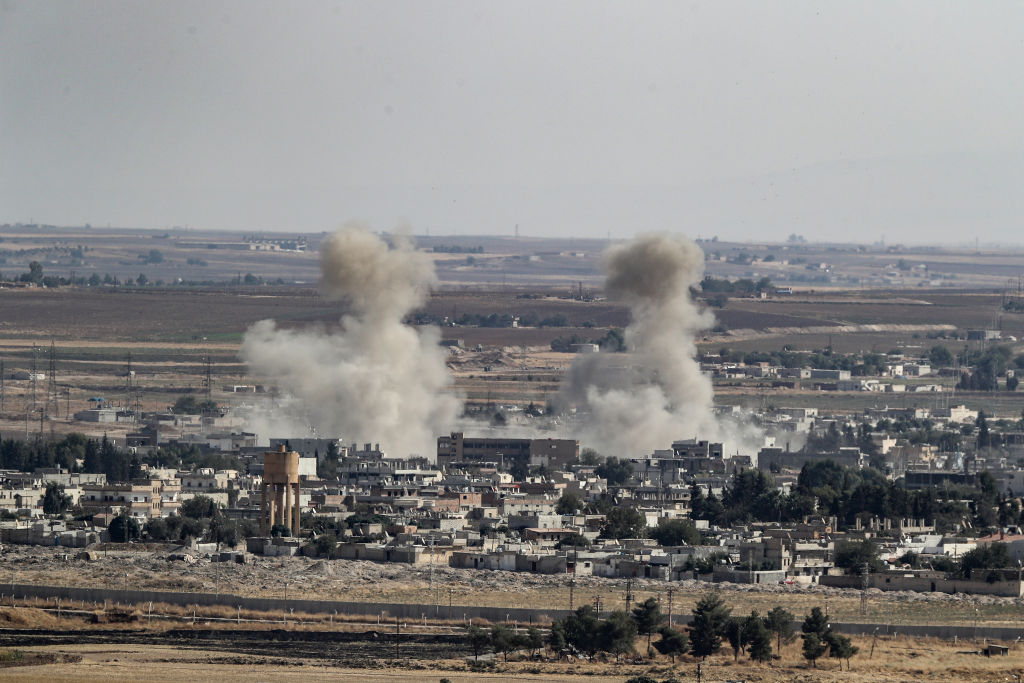by Malcolm Lowe • October 16th
As the Voice of America itself reported on January 23, Erdogan's plan was to resettle three million or more refugees from other parts of Syria in this "security zone" extending twenty miles deep into Syria. Twenty miles may not sound much, but – the VOA omitted to mention – almost all the Kurdish towns of northeastern Syria lie within that area. So Erdogan's intention to annihilate the Kurdish presence in that area and replace it with others has been manifest ever since the beginning of 2019.
A whole series of Trump's Republican supporters in the Senate expressed outrage over his decision, starting with Lindsey Graham ("Pray for our Kurdish allies who have been shamelessly abandoned by the Trump Administration") and continuing with Mitch McConnell, the Senate majority leader, who remarked: "As we learned the hard way during the Obama Administration, American interests are best served by American leadership, not by retreat or withdrawal."

It is now clear that Turkish President Recep Tayyip Erdogan intended the annihilation of the Syrian Kurds already two years ago. (Photo by Getty Images)
It is now clear that Turkish President Recep Tayyip Erdogan intended the annihilation of the Syrian Kurds already two years ago. Moreover, his plans became evident to the US military by the beginning of 2019 and were conveyed to President Trump at that time.
In order to disguise his plans, Erdogan revealed them stage by stage, by making first lesser and then greater demands on the US military, to which Trump agreed -- sometimes in the course of telephone conversations with Erdogan. So Erdogan was able to hoodwink the US military up to January 2019 and to hoodwink Trump up to the current invasion: Trump resolutely defied contrary advice from the military (and from everyone else).
by Erick Stakelbeck • October 16th
The U.S. Congress is looking to push back against Erdogan's brazen foray into northeastern Syria. For months, there has been a bi-partisan effort on Capitol Hill to convince the Trump administration to implement sanctions on Turkey in the wake of its purchase of the Russian S-400 missile system. The events of this past week will likely only escalate pressure by Congress against the Erdogan regime.
"We defeated ISIS," a Peshmerga general said, "only to see Iran and its Shia militias become stronger. They are filling the vacuum."
Islamist-led Turkey has now joined those same Iranian-led forces in filling that vacuum — with the full acquiescence of the United States.

Turkish President Recep Tayyip Erdogan's longstanding threat to invade northeastern Syria — under the pretext of targeting terrorists from the Kurdistan Workers' Party (PKK) — has become a reality. Pictured: Smoke from battle explosions rises over the Syrian town of Ras al-Ain, near the Turkish border, on October 15, 2019. (Photo by Burak Kara/Getty Images)
On the Iran-Iraq border a few weeks ago, I found myself just a few hundred meters from Iran's Islamic Revolutionary Guard Corps (IRGC), standard bearers of a regime that has practically copyrighted the phrases, "Death to America" and "Death to Israel."
At the Kurdish Peshmerga military base stood a series of small, white structures spread out across the mountaintops on the Iranian side of the border.
"IRGC observation posts," said one of my Kurdish hosts, eying the mountains warily.
The Pershmerga generals interviewed in Iraqi Kurdistan seemed eager to talk about the threat posed by the IRGC and the Iranian regime—not only to the Kurds, Israel and the broader Middle East, but also to the United States.
They were understandably more reticent, however, in discussing the other looming threat in their immediate neighborhood — an increasingly aggressive Turkey, led by Islamist strongman President Recep Tayyip Erdogan.
|
|



No comments:
Post a Comment